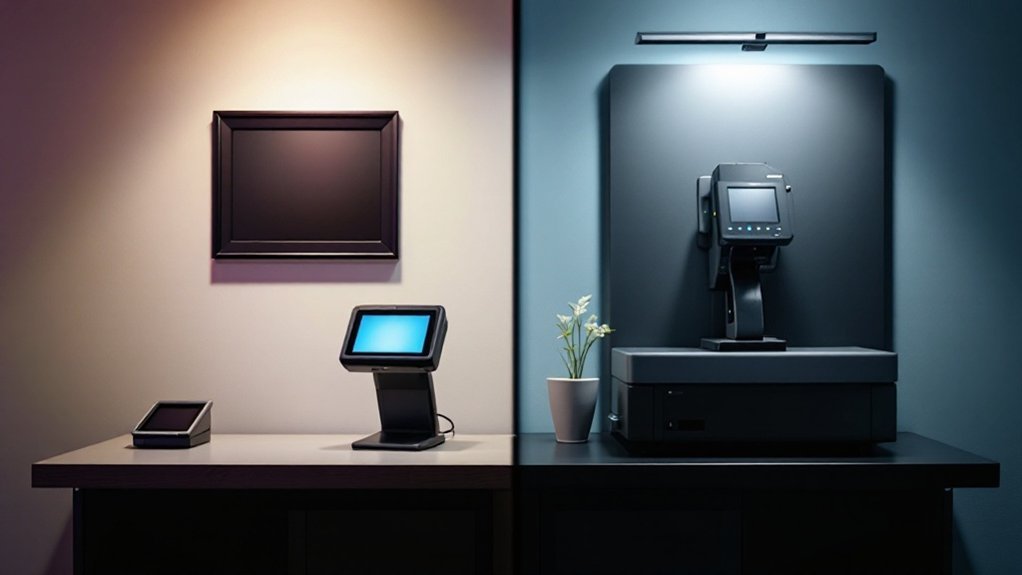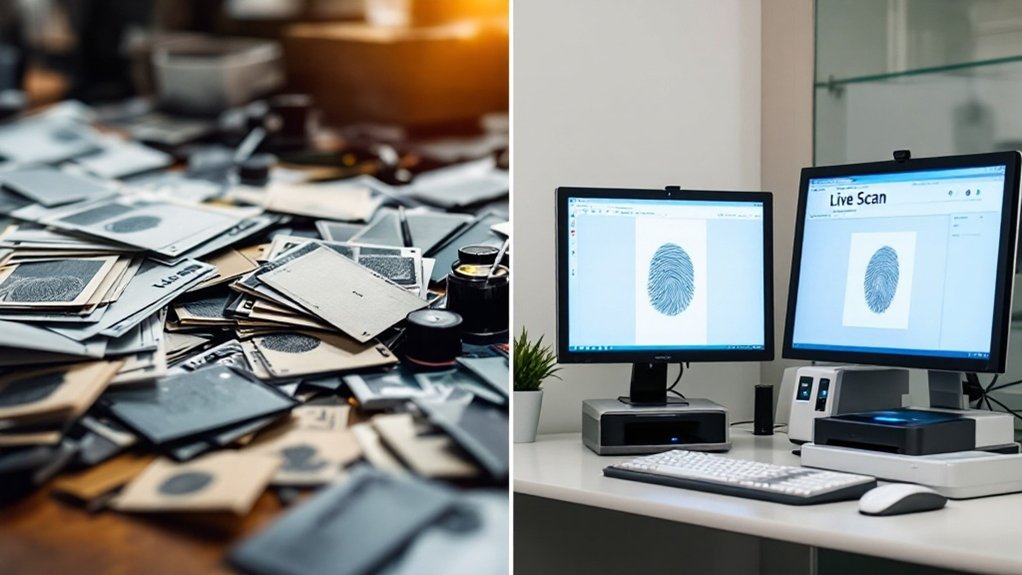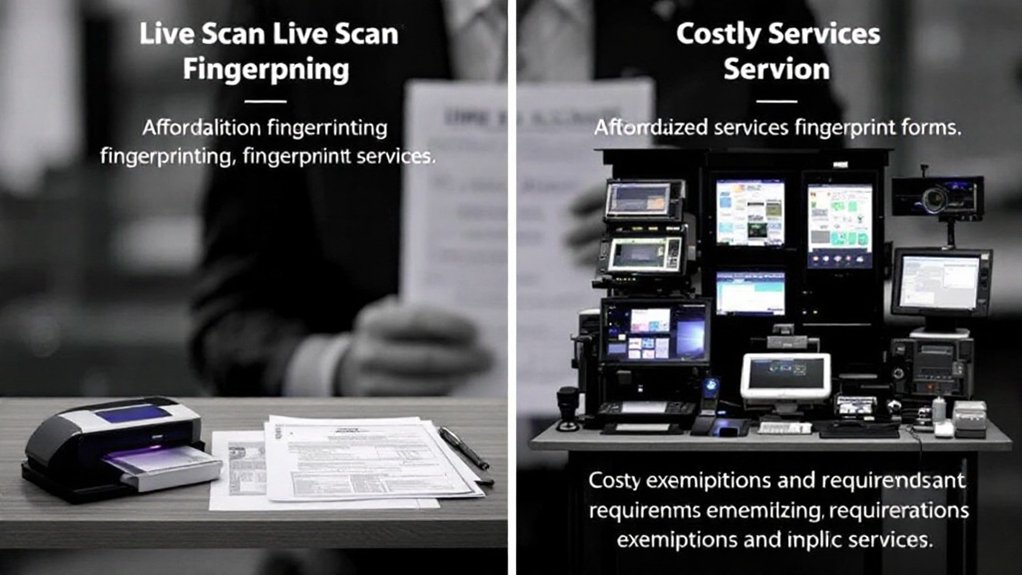When evaluating live scan services, you’ll encounter costs ranging from $4,000 to $12,000 for equipment, depending on the model and features. Established brands like Thales and Suprema are pricier due to their quality. Service fees typically range from $20 to $50, influenced by location and provider. Government charges add to the cost. You can choose between affordable and costly services based on your needs. Continuing to explore these options will help you optimize cost and convenience.
Understanding Live Scan Costs

Understanding Live Scan costs involves considering several key factors. You’ll need to think about the equipment costs, which can range from $6,800 to $12,000, depending on the model and features. Third-party service providers offer Live Scan services, making it more accessible and cost-effective than purchasing equipment. Costs can vary by location and service provider, with some offering additional services like mobile events. Established brands like Thales and Suprema are often more expensive due to their quality and reliability. Additionally, different states and agencies may have specific requirements affecting the cost and process of Live Scan services. When using Live Scan services, it’s important to note that fees, such as the DOJ fee, may be changed by the agency at any time without notice.
Service Fees and Government Charges
When you’re considering Live Scan services, you’ll encounter service fees that typically range from $20 to $50, depending on the provider and location. Government charges, such as those from the California Department of Justice (DOJ) and the Federal Bureau of Investigation (FBI), add to the total cost, with DOJ fees generally around $32 and FBI fees around $17. You should also be aware that additional charges might apply, such as travel or after-hours fees for mobile services, which can differ substantially between providers. Live Scan services offer the advantage of digital capture, which enhances accuracy and efficiency by eliminating the need for ink and reducing processing time.
Service Fees
Live Scan service fees exhibit significant variability, typically ranging from $20 to $50, depending on the provider and location. You’ll notice that different providers charge different rolling fees; for example, Total Live Scan charges $40. Higher fees often reflect better service quality and more efficient processing, which can justify the cost compared to traditional methods. When choosing a Live Scan service, consider factors like the provider’s network size and technology costs, which can influence fees. Mobile services and additional offerings like notary services may also impact your total cost. Despite higher upfront costs, Live Scan’s digital convenience and accuracy can lead to long-term savings by reducing errors and resubmissions. Additionally, the overall cost of Live Scan services can be affected by additional government fees such as those charged by the California DOJ and FBI.
Government Charges
Government charges for Live Scan services include specific fees that you’ll need to pay in addition to the service provider’s rolling fee. The Department of Justice (DOJ) typically charges $32 for checks, while the Federal Bureau of Investigation (FBI) fee is usually $17. There may also be a “child fee” of around $15 for certain applications. Additionally, a DOJ record review might cost $25. These fees can vary, so it’s essential to confirm them with the DOJ.
When it comes to billing, you might have a billing number to cover these government fees, or your agency might handle them directly. Costs can be distributed among you, your agency, or a combination of both. Non-profit organizations may have waived DOJ fees for volunteers.
Benefits of Live Scan Technology

As you explore Live Scan technology, you’ll find it offers significant advantages over traditional methods. By capturing fingerprints digitally and submitting them electronically, Live Scan guarantees faster processing times, typically within 24 to 72 hours, and reduces errors associated with ink-based methods. This technology not only enhances accuracy and efficiency but also provides a more secure and convenient experience, making it a preferred choice for various applications. Additionally, Live Scan ensures secure transmission of fingerprints directly to state or federal agencies, reducing risks associated with physical cards and improving data privacy.
Benefits of Live Scan Technology
When you opt for Live Scan fingerprinting, you benefit from a process that is considerably faster and more precise than traditional ink methods. This technology allows for immediate electronic submission of fingerprints, reducing waiting times for background check results. The digital process minimizes errors and guarantees secure data transmission, enhancing reliability and compliance with regulatory standards.
Live Scan also offers convenience by being a clean and sanitary process, eliminating the need for ink. It is available at numerous locations and can be used for various applications, including employment and licensing. Additionally, technicians can retake prints if they are unclear, verifying high-quality images.
Digital Accuracy
Live Scan fingerprinting’s digital accuracy is a significant advantage over traditional ink methods. You benefit from reduced errors, such as smudging or incomplete prints, and high-resolution images that enhance precision and clarity. The electronic process minimizes human error by allowing technicians to retake prints multiple times, ensuring clearer results without smudging or smearing.
Traditional Ink Fingerprinting Comparison
Traditional ink fingerprinting is a well-established method that involves pressing your fingers onto an ink pad and then rolling them onto a paper card to capture your fingerprints. This technique is widely recognized and accessible, even in areas with limited technology. It’s cost-effective due to minimal equipment needs, making it suitable for various government applications.
When comparing ink fingerprinting to live scan, you’ll notice that live scan offers higher accuracy and speed. Live scan eliminates the mess and potential for smudging associated with ink, providing a cleaner and more efficient process. While ink fingerprinting is more affordable initially, live scan’s digital storage and transfer capabilities make it more convenient and environmentally friendly in the long run. Additionally, live scan’s ability to store fingerprints digitally reduces the risk of physical damage, such as degradation over time, which can affect physical cards.
Approved Live Scan Providers

To find an approved Live Scan provider, you can choose from a variety of options that offer efficient and accurate fingerprinting services. Certifix Live Scan operates a vast network of over 1200 locations across the U.S., providing both Live Scan and fingerprint card services. IdentoGO Centers specialize in serving various state agencies and industries, ensuring fast and accurate processing. These providers often require online enrollment before visiting a location, which helps streamline the fingerprinting process for applicants. You can also consider state-specific providers, such as those in Maryland, or UPS locations partnered with Certifix. Additionally, many private providers offer Live Scan services with online enrollment options. These providers cater to multiple industries and purposes, ensuring convenience and speed in the fingerprinting process.
Choosing the Right Service Provider
When selecting a Live Scan fingerprinting service provider, you should prioritize several key factors to guarantee you receive high-quality, efficient, and compliant services. Compliance with regulatory bodies is imperative, ascertaining operations meet legal standards. Advanced technology is also essential for precise results and quick processing. Extensive training and constant support are vital for addressing technical issues.
Consider a provider’s experience, convenience, and customer service. Competitive pricing and a positive reputation are also important. Assess operational efficiency by evaluating market demand, operational speed, and error reduction. Confirm the provider meets necessary certifications and standards, offers user-friendly technology, and provides a nationwide network for convenience.
Exemptions and Requirements for Live Scan

How do you navigate the exemptions and requirements for Live Scan fingerprinting services? You need to comprehend specific exemptions, such as those for outside directors without access to sensitive information or individuals with physical handicaps. Additionally, certain employees in the securities industry may be exempt if they don’t handle securities or monies. When using Live Scan services, guarantee that the equipment meets FBI standards for interoperability with law enforcement systems. Live Scan offers high accuracy and immediate electronic submission, but it’s generally more expensive than traditional methods. Adherence to FBI and state regulations is imperative for electronic submissions. Furthermore, alternatives to traditional fingerprint cards, such as a legible photocopy, can be used under specific conditions, ensuring compliance with regulatory requirements.
Optimizing Cost and Convenience**
Optimizing the cost and convenience of Live Scan fingerprinting services involves understanding the various factors that influence pricing and accessibility. You can reduce costs by comparing rolling fees among providers, which typically range from $10 to $35, and using billing numbers if available to waive government fees. Additionally, checking state-specific fees guarantees accurate cost estimation.
To enhance convenience, consider the speed and accuracy of Live Scan, which takes about 15 minutes and offers high accuracy with digital technology. Mobile services provide flexibility, though they may be more expensive. Group discounts can also lower costs per applicant, making the process more affordable and efficient. Furthermore, understanding the Government Database Fees helps in planning the overall cost, as these fees can vary based on the agency’s arrangement with the state.
Conclusion
You’ve navigated the labyrinth of Live Scan costs, where fees can range from $10 to $500, depending on your location and the agency’s whims. It’s a thrilling adventure of rolling fees and government charges. Live Scan’s accuracy and speed are a beacon of hope, but ink fingerprinting’s affordability is a siren’s call. Choose wisely, or you might find yourself lost in a sea of paperwork and bills.

